The Indian Spitz, often mistaken for a mini Samoyed, is a homegrown companion breed with colonial roots. Originally bred from German Spitz stock during British rule, they were adapted for India’s climate and lifestyle—earning their place as the middle-class family dog of the ’80s and ’90s. Known for their alertness, fluffy charm, and chatty personalities, Indian Spitz dogs were once household stars—riding scooters with their humans or guarding the front gate with serious (and slightly exaggerated) determination.
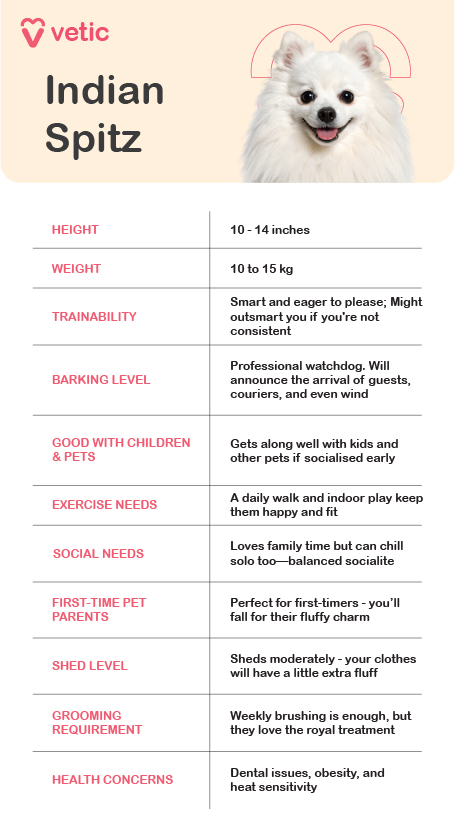
Indian Spitz Puppy: Nutrition and Grooming Guide That Won’t Confuse You
What Should You Feed an Indian Spitz Puppy?
So, you’ve brought home an Indian Spitz puppy—part cotton ball, part watchdog, and 100% energy. These fluffballs grow fast, bounce faster, and bark at everything (including their own reflection). To keep up with all that excitement, they need nutrition that fuels growth and mischief.
Let’s break it down like a no-nonsense dog parent guide.
Puppy Fuel 101: What Goes in the Bowl?
Protein, Please
Think chicken, eggs, fish, or lean mutton. These give your Spitz the muscle to leap from sofa to bed in one glorious zoomie sprint.
Good Fat = Smart Pup + Fluffy Coat
Omega-3s and 6s help brain development and give that white, cloud-like coat its fluff factor. Plus, they’ll outshine your pillow in softness.
Good Carbs Only
Sweet potato, oats, brown rice—basically, energy sources that don’t come from junk. No, parathas don’t count.
Vitamins & Minerals
Tiny bones, growing fast. So they need calcium, phosphorus, and the usual A, D, E squad to keep their bones strong and skin healthy.
Puppy Food Options That Make Sense
Dry Kibble
Pick a small-breed puppy formula. Their tiny jaws can’t handle the chunky kibble meant for Great Danes. Go for brands that don’t bulk up food with fillers.
Wet Food
Helpful if your pup turns into a dramatic foodie. Wet food is tastier, easier to eat, and great for hydration—but make sure it’s puppy-appropriate.
Home-cooked? Sure, But With Caution
Cooked chicken, pumpkin, peas, and brown rice are safe. But no onions, garlic, spices, or salt (yes, even if they beg with those eyes). Always check with your vet for proportions.
Feeding Schedule for Spitz Puppies
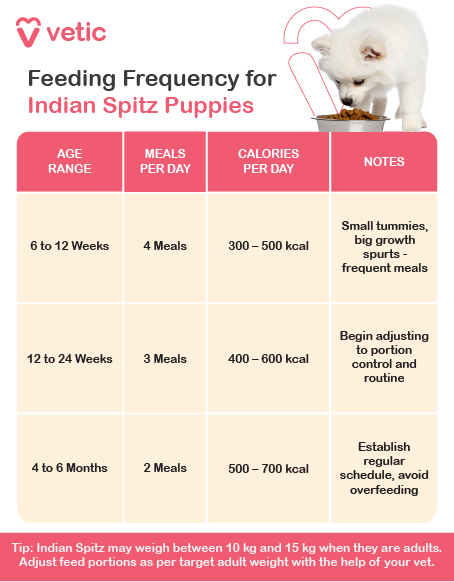
Here’s a timeline your Indian Spitz pup will appreciate (and bark for):
- 8–12 weeks: 4 small meals a day. They burn calories faster than you can say “sit.”
- 3–6 months: Down to 3 meals. More eating, less teething drama.
- 6 months and beyond: 2 meals a day, consistently. Keeps tummy troubles away and helps with routine training.
Pro Tip: Feed at the same time every day. They will remind you if you forget.
Grooming Needs of an Indian Spitz Puppy
You’ve seen the fluff. Now, meet the truth: that fluff doesn’t manage itself. But don’t worry—it’s not all brush and no play.
Fluff Care Basics
Brushing
Their double coat needs brushing 3–4 times a week. Not just for looks—this keeps mats, tangles, and sneaky ticks away. Bonus: less fur on your black clothes.
Bathing
Once every 4–6 weeks. Unless they roll in suspicious substances (which they will). Use a mild dog shampoo, and never human stuff—it messes with their skin.
Ear Cleaning
Those upright ears don’t trap as much moisture, but dust and wax still party there. Clean once a week with a vet-approved solution.
Nail Trimming
Every 3–4 weeks. If your pup click-clacks across the floor like tap shoes, it’s time.
What About Dental Care?
That little jaw? It’s full of future dental bills—unless you brush. Use a dog-safe toothbrush and toothpaste, 2–3 times a week. Start early so they don’t act like you’re trying to steal their soul.
TL;DR – Indian Spitz Puppy Nutrition & Grooming Care at a Glance
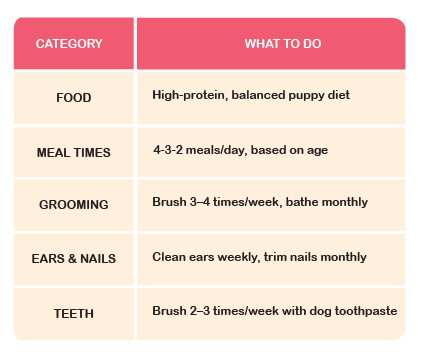
Final Word from Your Friendly Spitz Whisperer
Indian Spitz puppies are like energetic clouds with opinions. Feed them well, groom them often, and you’ll have a loyal, clever, drama-loving companion for years to come. And when they bark at a plastic bag for the 10th time, just remember: they’re trying to protect you. From trash.
Indian Spitz Puppy: Complete Healthcare Guide
Preventive Care and Vaccination Schedule
Vaccinations: What Your Indian Spitz Needs and When
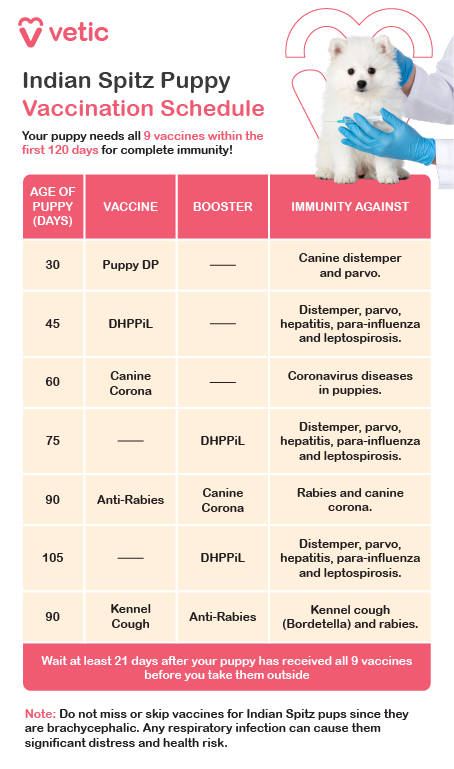
An Indian Spitz puppy might look like a snowball, but their immune system starts off pretty bare. That’s why vaccinations are your puppy’s first shield against serious illnesses.
Here’s a typical vaccine timeline:
- 6–8 Weeks: The first round begins—Distemper and Parvovirus. Think of it as their starter kit.
- 10–12 Weeks: Time for boosters. This round usually includes Distemper, Parvovirus, Hepatitis, Leptospirosis, and Parainfluenza. Your vet may also give the Rabies shot here, depending on your area’s rules.
- 14–16 Weeks: Final core vaccinations. If Rabies hasn’t been given earlier, now’s the time.
- 6 Months: Lifestyle-based extras. If your Spitz is heading to day-care, boarding, or dog parks, your vet may recommend kennel cough, or even canine corona vaccines.
Stick to this schedule, and you’re setting your fluffball up for a healthier, more worry-free life.
Parasite Control: Winning the War Against the Itchy Stuff
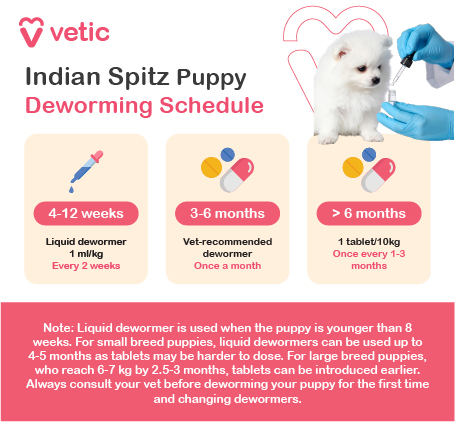
Indian Spitz dogs have a thick double coat—lovely to look at, a nightmare for fleas and ticks. Don’t wait for a scratching spree to begin parasite prevention.
Flea and Tick Prevention
Start topical or oral treatments at 8 weeks, with your vet’s advice. Regular brushing helps spot trouble early (and keeps the fluff under control).
Heartworm Prevention
Mosquitoes aren’t just annoying—they can transmit heartworm. Begin monthly preventives by 12 weeks, especially if you’re in a warm or humid area.
Routine Vet Visits: Keeping the Tail Wagging
During those first few months (from 6 to 16 weeks), plan vet visits every 3–4 weeks. These appointments aren’t just about jabs—they help monitor growth, nutrition, teething, behavior, and all the tiny things that make a big difference later.
Think of it as your pup’s personal wellness tracker—plus, your vet can answer all the “Is this normal?” questions.
Health Risks in Indian Spitz Puppies: What to Keep an Eye On
The Indian Spitz is generally a healthy and hardy breed, but like all dogs, they have their own set of potential issues. Catching things early can save a lot of stress (and vet bills).
Eye Problems
Indian Spitz dogs can be prone to eye ulcers and tear stains. If there’s redness, squinting, or excessive tearing, it’s worth a vet visit.
Inguinal Hernia (in females)
Some Spitz females may develop a small bulge in the groin area, which needs monitoring—or in some cases, minor surgery.
Dental Issues
Those tiny jaws can hide tartar buildup or misaligned teeth. Brushing early helps avoid smelly surprises later.
Obesity
Yes, even your lively Spitz can gain weight if you’re too generous with treats. Stick to portion sizes and don’t give in to the “puppy eyes” every time.
Skin Troubles
They might develop dry skin or minor allergies, especially in extreme weather. Watch for excessive scratching, dandruff, or redness.
Signs You Should Never Ignore
Puppies are quirky by nature—but some signs should raise red flags. Call your vet if you notice:
- Fatigue or low energy that doesn’t bounce back after rest
- Frequent vomiting or loose stools
- Breathing difficulties or persistent coughing
- Intense scratching or licking of the same spot
- Sudden changes in appetite, water intake, or mood
A Final Note from the Spitz Sidekick
Your Indian Spitz puppy is curious, clever, and (let’s be honest) a little dramatic. But that’s what makes them so lovable. Keeping them healthy doesn’t require rocket science—just timely vaccinations, a watchful eye, and regular vet visits. Do that, and you’ll have a healthy, tail-wagging companion who’s always ready to bark at the neighbour’s cat.
Indian Spitz Puppy: Activities, Exercise, and Training Guide
Physical Activities: Fun, Not Frenzy
Indian Spitz puppies are like little whirlwinds wrapped in fluff. They have energy to spare, but their growing joints and developing stamina mean moderation is key.
Play, But Keep It Chill
Spitz pups love attention and games—but short, fun bursts are best. Think gentle tug-of-war, soft fetch in the hallway, or chasing a crumpled paper ball (yep, they love the cheap stuff). The goal? Tired, not overtired.
Walks, Not Workouts
Start with 10–15 minute strolls, 2–3 times a day. No need to climb Everest—flat, safe areas work just fine. Avoid long treks, stairs, or intense running until your vet gives a thumbs-up.
Play Indoors Too
Rainy day? No problem. They’ll happily burn energy inside with hallway zoomies or hide-and-seek under the couch. Just keep your slippers out of reach.
Training: Small Dog, Big Brain
The Indian Spitz may be small, but they’re clever, alert, and love a mental challenge. That also means they’ll learn fast—and misbehave faster if you let them.
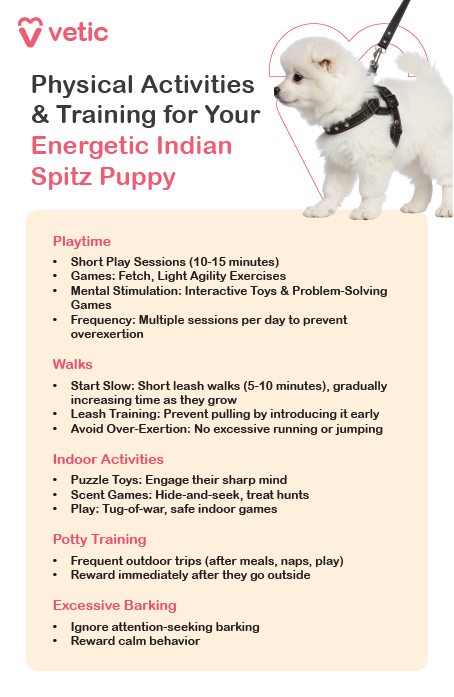
House Training
Start crate training early. Take your pup out after meals, naps, and playtime. Celebrate successful potty breaks like they just won a medal.
Commands to Start With
“Sit”, “stay”, “come”, “down”—keep it basic, short, and clear. Reward with small treats, praise, or your best excited-human voice.
Socialisation is a Must
Expose your Spitz to people, pets, vehicles, and surfaces like grass, tiles, or elevators. The earlier they learn the world is friendly, the more confident they grow.
Mental Stimulation: Keep That Sharp Mind Busy
Indian Spitz dogs are alert, inquisitive, and occasionally dramatic. Boredom turns them into barky escape artists or household critics.
Try these to keep their mind (and mouth) engaged:
- Puzzle toys or snuffle mats
- Hide-and-seek with treats
- Learning names of toys (yes, they can)
- Indoor obstacle courses using chairs, cushions, and tunnels
Mental workouts are just as tiring as physical ones—and way more sofa-friendly.
Common Behaviour Issues in Indian Spitz Puppies
Let’s be honest: no puppy is perfect. Here’s what might come up with a Spitz—and how to handle it.
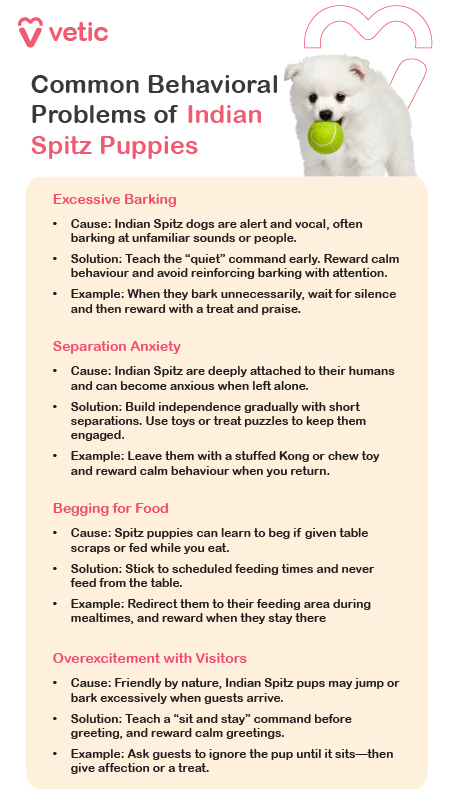
Chewing
They’ll chew anything during teething: slippers, wires, your favourite pen. Rotate safe chew toys and freeze a carrot or rubber toy to soothe sore gums.
Barking
Spitz pups are vocal. They’ll bark at the bell, the breeze, and occasionally, nothing at all. Figure out what’s triggering it—then redirect with a command, game, or training cue.
Jumping
They love attention and might try jumping up to get it. Nip this early. Reward calm greetings and teach a “sit to say hi” routine.
Training Strategies That Actually Work
- Redirection: If they’re chewing the table leg, offer a toy instead. Praise them like they just solved a Rubik’s cube when they choose right.
- Positive Reinforcement: Treats, kind words, belly rubs—reward the good stuff generously.
- Consistency: Same commands, same timing, same tone. Mixed signals = confused puppy.
Spitz dogs are sensitive. They’ll notice if one person lets them on the sofa and the other yells about it. So get the family on the same page.
Separation Anxiety: The Fluffy Velcro Pup
Indian Spitz puppies form strong bonds and don’t take kindly to being left behind. But learning independence is crucial.
Start small:
- Leave the room for a few minutes and gradually increase the time.
- Offer a safe toy or something with your scent when you step away.
- No dramatic goodbyes—they pick up on that!
Soon, your pup will learn that you always come back (and usually with food).
Final Word from the Indian Spitz Fan Club
Indian Spitz puppies are spunky, smart, and full of love. But they need structure, play, and patience—especially during those chaotic, chewy months. Build a routine, laugh through the mischief, and you’ll end up with a well-trained fluffball who’s alert, affectionate, and always one step ahead of your plans.
Indian Spitz Adolescent: Nutrition & Grooming Guide That Keeps Up With the Fluff
Welcome to the adolescent phase—where your Indian Spitz puppy transforms from a fuzzy little ball of curiosity into a confident, occasionally rebellious, yet totally lovable young adult. Between the zoomies, mood swings, and sudden fascination with barking at ceiling fans, this is a critical stage for their development. And guess what? Nutrition and grooming play a massive role in shaping them into their best selves.
Nutrition for Adolescent Indian Spitz Dogs
Indian Spitz adolescents are small-to-medium-sized dynamos with big appetites and faster metabolisms than you’d think. The goal here? Fuel growth without overfeeding, because a chonky Spitz is not a happy Spitz.
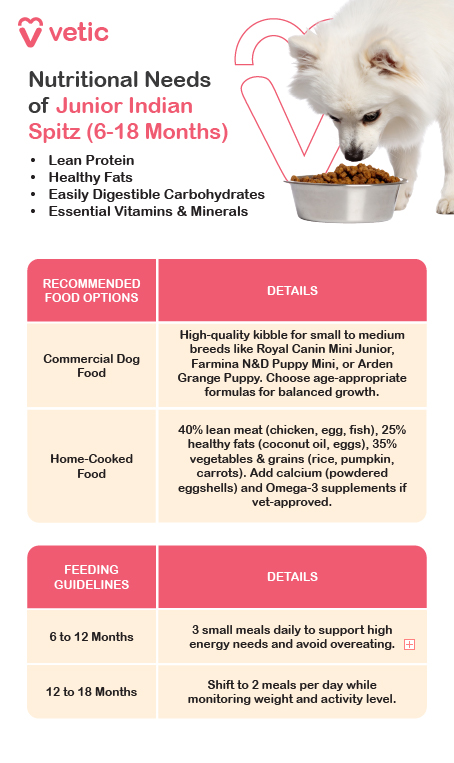
What They Need (and Why)
Protein for Lean Muscle
Stick to high-quality sources like chicken, turkey, fish, or eggs. These help build strong muscles and support that graceful, bouncy stride they’re developing.
Healthy Fats
Omega-3 and 6 fatty acids keep their brain sharp and that glorious double coat shiny and soft. Think of it as brain food and beauty care rolled into one.
Complex Carbs
Brown rice, oats, and sweet potatoes provide steady energy—perfect for all those mid-zoom naps and late-night energy bursts.
Vitamins & Minerals
Calcium and phosphorus support growing bones. Add in vitamins A, D, and E to keep their immune system strong and their skin irritation-free.
What Should Go in the Bowl?
Dry Kibble
Choose small- to medium-breed adolescent formulas. These are designed for breeds like the Indian Spitz that are light on size but high on activity. Look for brands that don’t sneak in artificial fillers.
Wet Food
Works well as a mix-in or a treat, especially if your Spitz gets bored easily (which they do). Just make sure it meets their daily nutrient requirements.
Home-Cooked Meals
If you’re the home-chef type, kudos! But balance is everything. Include lean meats, veggies like carrots and pumpkin, and whole grains. Always check with your vet to avoid missing out on vital micronutrients.
Feeding Schedule: Keep It Consistent
- 6–12 Months: 2 to 3 meals a day, depending on activity level
- 12–18 Months: Settle into 2 meals a day
Stick to regular meal times, use proper measuring tools, and don’t let your Spitz guilt-trip you into endless snacks. Trust us, they’ll try.
Grooming Needs of an Adolescent Indian Spitz
You’ve probably noticed by now—this breed comes with a coat. A glorious, feathery, snow-like coat that somehow ends up on every piece of black clothing you own. Grooming is no longer optional—it’s your bonding ritual.
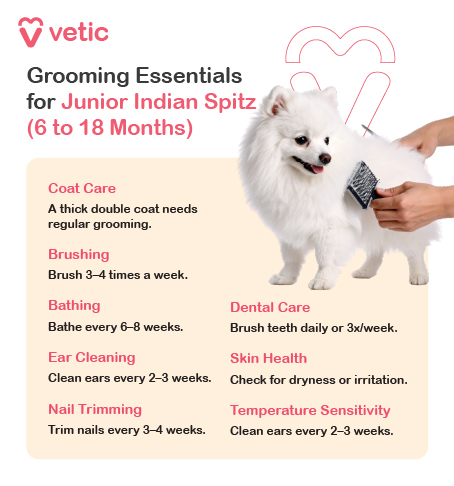
Coat Care: Get That Shedding Under Control
Brushing
3–4 times a week is ideal. Use a slicker or de-shedding brush to keep mats and shedding in check. More brushing = less vacuuming.
Bathing
Every 6–8 weeks, or as needed. Over-bathing can dry out their skin, so use a mild dog shampoo and rinse thoroughly. And no, baby shampoo doesn’t count.
Ear Cleaning
Even though their ears stand upright, dirt and wax still make themselves at home. Clean weekly with a gentle ear cleanser—especially if your Spitz has a love-hate relationship with dust.
Nail Trimming
Every 3–4 weeks. If your dog sounds like they’re tap-dancing across the floor, it’s time for a trim.
Don’t Forget the Teeth
Dental care matters—even if your Spitz disagrees.
- Brush 2–3 times a week with dog-safe toothpaste.
- Offer dental chews to help with plaque and keep that puppy breath from turning toxic.
Final Thoughts from the Spitz Enthusiast
Your Indian Spitz adolescent is curious, spirited, and constantly testing boundaries. This is the phase where good habits start to stick—so a balanced diet and regular grooming routine are more important than ever. With a little structure, a lot of love, and the occasional bribe (read: treat), you’re well on your way to raising a healthy, confident, camera-ready Indian Spitz.
Indian Spitz Adolescent: Complete Healthcare Guide
Between 6 and 18 months, your Indian Spitz isn’t quite a puppy anymore—but still very much a work in progress. This is the phase where their energy spikes, independence blossoms, and their body starts settling into adult form. From vaccinations to vet visits, here’s everything you need to keep your growing fluffball healthy and thriving.
Preventive Care and Vaccination Schedule
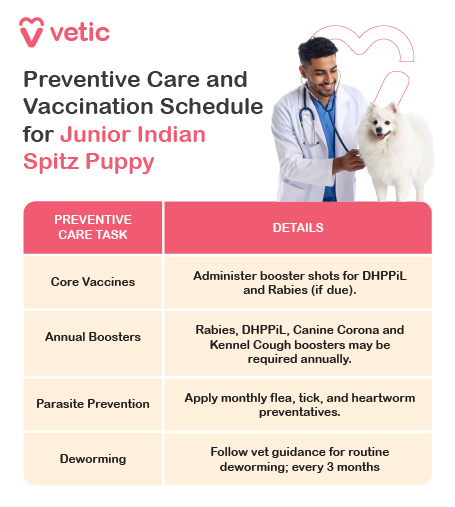
Vaccinations: Stay On Track
By adolescence, your Indian Spitz should have completed their primary puppy vaccine series. But you’re not off the hook—this is when booster doses and lifestyle-based vaccines come into play.
12 Months:
Time for boosters of the core vaccines—Distemper, Parvovirus, and Rabies. Your vet will adjust based on what was given earlier.
Optional Vaccines:
If your Spitz is a social butterfly or loves dog parks, boarding, or travel, your vet might recommend additional protection like Bordetella, or Canine Corona.
Parasite Control: Still a Top Priority
That thick double coat isn’t just a shedding machine—it’s also an open invitation for fleas and ticks if you let your guard down.
Flea & Tick Prevention
Stick with monthly topical or oral treatments recommended by your vet. And don’t forget regular brushing to catch any freeloaders early.
Heartworm Prevention
If you live in a mosquito-prone area, monthly heartworm medication is a must. Prevention is way easier (and cheaper) than treatment.
Vet Visits: Don’t Skip the Check-Ups
Even if your Spitz seems perfectly healthy, schedule a vet check-up every 6 months during adolescence. These visits help track growth, spot early signs of joint issues, and make sure their nutrition and development are on point.
And if your usually bouncy pup suddenly turns moody, itchy, or sluggish—bring it up. You know your dog best.
Health Risks in Adolescent Indian Spitz Dogs
The Indian Spitz is generally a hardy breed—but no dog is immune to health hiccups. Here’s what to keep an eye on as they grow:
Joint Stress
Yes, even smaller dogs can struggle with joint pressure during growth spurts. Limping, reluctance to jump, or “funny walks” are worth a vet visit.
Obesity
With their sharp minds and pleading eyes, Spitz dogs are expert snack negotiators. But extra weight puts stress on their joints and heart. Measure meals and limit treats—even if it feels like betrayal.
Ear Issues
Their upright ears are less prone to infection than floppy-eared breeds, but they still need weekly cleaning. Look out for wax build-up, odour, or excessive scratching.
Gastro Troubles
Teenage Spitz dogs are curious (read: nosy). Eating from the bin, licking mystery puddles—it happens. If you spot vomiting, bloating, or irregular stools, call the vet.
Red Flags You Shouldn’t Ignore
Not every change is a phase. Here’s when you should trust your instincts and head to the vet:
- Sudden weight gain or loss
- Lethargy or drop in activity
- Unexplained scratching or licking
- Change in appetite, thirst, or urination
- Behaviour that feels “off” or unusually clingy or withdrawn
Final Thoughts from the Spitz Sidekick
This stage is part adorable, part unpredictable. Your Indian Spitz is figuring out the world—and their place in it. With the right healthcare habits and a watchful eye, you’ll be setting them up for a long, healthy, tail-wagging life.
Indian Spitz Junior: Training and Behaviour Guide
Adolescence in Indian Spitz dogs (roughly 6 to 18 months) is part delightful, part dramatic. Your once cuddly pup is now a fluffy ball of opinions—running the house like they own it and questioning every command like a teenage rebel. But with the right mix of exercise, stimulation, and structure, this is also when your Spitz begins to shine as a smart, well-mannered adult.
Activities, Exercise, and Training
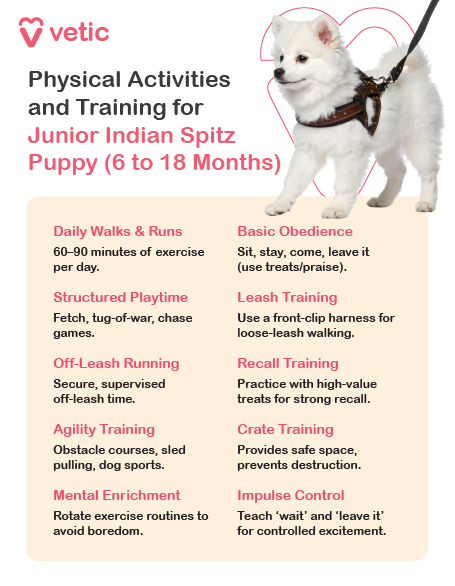
Physical Activities: Burn That Energy the Smart Way
Indian Spitz dogs aren’t marathon runners, but they’re incredibly active for their size. What they lack in size, they make up for in sass and stamina.
Daily Walks
Aim for two 20–30 minute walks a day. These walks help burn energy and offer mental enrichment—because yes, your Spitz needs to sniff every bush in the colony.
Indoor Games
A game of fetch with soft toys or running zigzags across the living room can be surprisingly effective. They love human attention and will happily participate in any game that involves you.
Low-Impact Play
Avoid repetitive jumping off sofas or stairs, especially while joints are still developing. They’re agile—but not invincible.
Training: Stay Sharp, Stay Consistent
The Indian Spitz is sharp, observant, and—let’s be honest—a little bossy. They learn fast, but if you’re inconsistent, they’ll happily take the lead (literally and figuratively).
Advanced Obedience
Work on leash manners, longer “stays,” and off-leash recall in distraction-heavy areas (if you’re brave). Spitz dogs respond best to short, focused sessions.
Impulse Control
Try exercises like “wait” before meals or “stay” at doors. These mini-lessons go a long way in improving patience and reducing hyper moments.
Ongoing Socialisation
Your adolescent Spitz may start becoming more cautious or reactive—don’t let that settle in. Keep introducing them to new sights, people, sounds, and settings with positive reinforcement.
Mental Stimulation: The Secret to a Happy Spitz
This breed is smart—and bored Spitz dogs can turn into barky, whiny little drama stars.
- Puzzle Toys: Keep them engaged when you’re busy.
- Scent Games: Hide treats under cups or in snuffle mats.
- Teach New Tricks: “Spin,” “high five,” “play dead”—they love a challenge and the applause.
Rotate toys regularly and avoid repetition—Spitz dogs are too clever to fall for the same trick twice.
Common Behaviour Issues (And How to Solve Them)
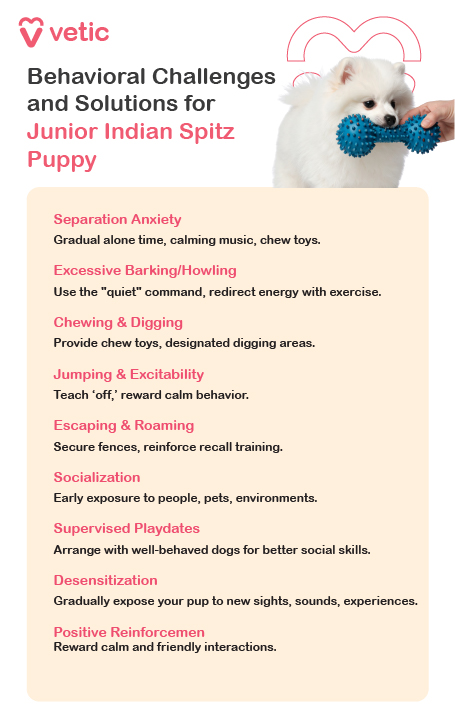
Chewing
Teething might be over, but boredom chewing? Very much a thing. Offer safe chew toys, and don’t leave your slippers lying around unless you’re ready to say goodbye.
Jumping
Spitz dogs greet with enthusiasm—sometimes too much. Reinforce a “sit to greet” routine and reward calm arrivals.
Mouthing or Nipping
Play-biting is common at this stage. Redirect to a toy, and if it gets rough, calmly disengage or stop the game to signal that it’s not okay.
Training Strategies That Work
Positive Reinforcement
Praise, small treats, a game of tug—find what motivates your Spitz and use it generously when they get it right.
Consistency Across the House
Mixed messages confuse them. Everyone should stick to the same commands and rules—even if your Spitz gives them “the look.”
Redirection Works Wonders
If they bark at guests, chew furniture, or dig indoors—redirect to a calm sit, a chew toy, or a training game. Don’t just say “no,” show them what to do.
Separation Anxiety: The Velcro Dog Dilemma
Spitz dogs bond deeply and may panic if left alone too long. Independence training is a must.
- Start with short absences, even just leaving them in another room.
- Leave a chew toy or puzzle when you go out.
- Create a safe space like a crate or cozy corner where they feel secure.
Practice leaving calmly—no over-the-top goodbyes. They’ll learn that you always come back.
Final Thoughts from the Spitz Sidekick
Your adolescent Indian Spitz might test limits, bark at the curtain, and chase shadows—but with the right structure, mental enrichment, and a whole lot of patience, you’ll end up with a confident, clever companion who knows when to shine and when to settle.
Indian Spitz Adult: Complete Nutrition Guide
The Indian Spitz may be small in size, but they have big personalities—and even bigger appetites. As they enter adulthood (typically from 12 to 18 months onward, up to around 7 years), their nutritional needs shift from “growing up” to “staying lean, sharp, and energetic.”
The goal now? Support their metabolism, maintain their beautiful coat, and keep that curious brain alert—without letting them turn into a little couch potato.
Nutritional Needs for Adult Indian Spitz Dogs
Indian Spitz dogs are generally active and lightweight, but they’re also quick to gain weight if overfed or under-exercised. A balanced diet is key to keeping them agile, healthy, and full of life.

Protein
Stick to lean animal proteins like chicken, fish, or turkey. These support muscle maintenance and keep them active without adding unwanted fat.
Healthy Fats
Omega-3 and omega-6 fatty acids (from fish oil, flaxseed, or chicken fat) promote a soft, fluffy coat and help with brain and skin health.
Complex Carbohydrates
Sweet potatoes, oats, and brown rice provide slow-release energy—ideal for their sporadic bursts of zoomies and long naps in between.
Fibre
A little added fibre helps keep digestion smooth and prevents overeating by making them feel fuller, longer.
Vitamins & Minerals
Look for foods with added antioxidants (like vitamin E and C), plus calcium and phosphorus for bones, and zinc for coat health. Some adult formulas also include joint support, which is a nice bonus—especially as they age.
Food Options: What’s in the Bowl?
Whether you prefer store-bought or home-cooked, what matters most is balance and consistency.
Commercial Kibble
Choose small- to medium-breed adult formulas from trusted brands like Royal Canin, Farmina, Orijen, or Acana. Look for options with coat care and digestive support.
Wet Food
Great for variety or for picky eaters. Just ensure it’s complete and balanced—wet food alone needs to cover all nutritional bases.
Home-Cooked Meals
If you like preparing fresh meals, go for lean meat (like chicken or eggs), steamed vegetables (pumpkin, carrots), and whole grains (rice or oats). But always consult your vet or a canine nutritionist to avoid nutrient gaps.
Feeding Frequency and Routine
12–18 Months and Beyond: Two meals per day work best for adult Indian Spitz dogs. Small, evenly spaced meals help regulate metabolism and avoid begging or bloat.
- Stick to a consistent schedule—morning and evening, same time every day.
- Use a measuring scoop to avoid overfeeding—Spitz dogs are small, so even a few extra bites add up.
- Avoid feeding right before or after intense play or walks. Let them rest to support digestion.
Final Thoughts from a Spitz Enthusiast
A well-fed Indian Spitz isn’t just a happy tail-wagger—it’s a dog with shiny fur, sharp instincts, and energy to chase butterflies (or bark at pigeons). With a balanced, portion-controlled diet, you’re giving your adult Spitz the foundation for long-term health—and fewer vet visits.
Indian Spitz Adult: Complete Healthcare Guide
The Indian Spitz is a lively, alert, and intelligent breed—and like every adult dog (typically from 12–18 months onward), they benefit from regular preventive care, grooming, and vet monitoring to stay in top form. Whether your Spitz is a cozy apartment dweller or a balcony watchdog, here’s how to care for them through adulthood.
Preventive Care and Vaccination Schedule
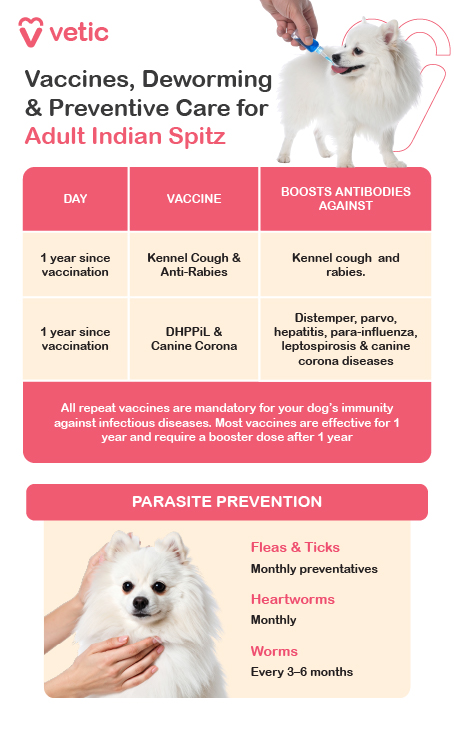
Vaccinations
By the time your Indian Spitz enters adulthood, they should be done with their primary vaccination schedule. But ongoing protection matters.
- Annual Boosters: Depending on your vet’s advice, your Spitz may need yearly boosters for core vaccines like Distemper, Parvovirus, and Rabies.
- Optional Vaccines: If your dog is frequently boarded, taken to parks, or interacts with other pets, your vet may recommend Bordetella, or Canine Corona vaccines.
Parasite Control
Flea and Tick Prevention
That double coat may be beautiful, but it’s also a tempting hideout for fleas and ticks. Stick to monthly oral or topical preventives as advised by your vet.
Heartworm Prevention
Mosquito-prone areas put your dog at risk for heartworm. A monthly preventive is a simple way to protect them year-round.
Regular Vet Check-Ups
Annual vet visits are a must—even if your Spitz looks and acts perfectly healthy. These check-ups help monitor:
- Weight and body condition
- Dental health
- Skin and coat condition
- Any early signs of metabolic or joint issues
Your vet might also recommend routine bloodwork starting at middle age (around 6–7 years) to screen for hidden health concerns.
Grooming Needs and Frequency

Coat Care
Indian Spitz dogs have a thick, double coat that sheds throughout the year—with extra fluff flying during seasonal changes.
- Brushing: 3–4 times a week using a slicker brush helps manage shedding and avoid tangles, especially around the neck, chest, and tail.
- Bathing: Bathe every 6–8 weeks, or when needed. Use a gentle dog shampoo to maintain coat health and avoid skin dryness.
- Ear Cleaning: Upright ears are less prone to infection, but dust and wax build-up still happen. Clean once a week with a vet-approved solution.
- Nail Trimming: Trim every 3–4 weeks. If you hear their nails tapping on the floor, it’s time.
Dental Care
Good dental hygiene is essential for long-term health—especially since small breeds like the Indian Spitz can be prone to tartar buildup.
- Brush teeth 2–3 times a week with dog-specific toothpaste.
- Use dental chews or water additives to supplement brushing if needed.
Health Risks and What to Watch Out For
The Indian Spitz is generally a healthy breed but may face a few breed-specific concerns:
Common Health Risks
- Obesity: Small breed, big appetite. Keep a close eye on weight, portion size, and daily activity to avoid excess weight gain.
- Eye Issues: Prone to tear stains or occasional corneal ulcers. Monitor for discharge, redness, or excessive rubbing.
- Inguinal Hernia: Occasionally seen in females—check for any groin-area swelling.
- Dental Disease: Regular dental care is key to preventing plaque, gum infections, or tooth loss in later years.
- Skin Dryness or Allergies: Their coat may be sensitive to harsh weather or shampoo. Use vet-recommended grooming products.
Signs to Watch For
Call your vet if you notice:
- Reluctance to walk, jump, or play
- Excessive scratching or licking
- Bad breath, drooling, or difficulty chewing
- Changes in appetite, weight, or energy levels
- Sudden mood shifts or signs of discomfort
Early detection is your best tool for long-term health.
Final Thoughts from the Spitz Sidekick
Adult Indian Spitz dogs are lively, loyal, and full of personality—but they need consistent care to stay that way. With proper vaccinations, grooming, regular vet visits, and a little attention to the little things, your adult Spitz will continue to charm the household with their sass, smarts, and that signature tail curl.
Indian Spitz Adult: Activities and Behavioural Training Guide
The Indian Spitz may not be a large breed, but when it comes to energy, alertness, and attitude—they pack it all in. As they transition fully into adulthood (roughly from 18 months onward), their training and activity needs shift from “puppy-proofing the house” to maintaining discipline, health, and mental engagement.
Activities, Exercise, and Training
Physical Activities: Keeping the Energy in Check
Indian Spitz dogs are lively, curious, and quick on their paws. Though they don’t need marathon workouts, they thrive with regular, structured activity.
Daily Walks
Aim for at least 45 minutes of walking per day, split into two sessions. Keep the pace brisk enough to engage them—but let them stop and sniff. It’s how they catch up on the neighbourhood gossip.
Interactive Play
These dogs love human interaction. Fetch (with smaller toys), short chases, or tug-of-war are excellent ways to keep them engaged indoors or in small outdoor spaces.
Safe Indoor Games
Stuck inside? Play hide-and-seek, practice commands, or use hallway fetch to help them burn off energy.
Training: A Sharp Mind Deserves a Challenge
The Indian Spitz is known for intelligence and independence—a mix that’s both delightful and occasionally defiant. Adult training helps refine behaviour and keep boredom at bay.
Advanced Commands
Build on basic obedience by adding commands like “wait,” “leave it,” “quiet,” and longer “stay” durations. Spitz dogs respond well to calm, clear direction.
Leash Manners
While small, they can pull and dart when excited. Use a harness and practise loose-leash walking in low-distraction areas before progressing to busier streets.
Socialisation
Although naturally alert, adult Spitz dogs may grow cautious or reactive if under-socialised. Take them on new routes, let them meet people and friendly pets, and expose them to different sounds and textures to maintain confidence.
Mental Stimulation: Outsmart the Smart Dog
Boredom in a Spitz can lead to excessive barking, chewing, or stubbornness. Keep their brains active with:
- Puzzle feeders and interactive toys
- Hide-and-seek with treats or toys
- New tricks and short training sessions
Rotate toys and vary games to avoid mental fatigue and keep that spark alive.
Behaviour Issues and Real-Life Fixes
Common Behaviour Problems
Chewing
Though less destructive than larger breeds, adult Spitz dogs may chew out of boredom or stress. Offer safe chew toys and supervise them in tempting environments (like your shoe rack).
Barking
This breed is known to be vocal—sometimes too vocal. Identify triggers (doorbells, movement outside) and use redirection or the “quiet” command. Reward silence like you would any other trick.
Jumping on Guests
Friendly? Yes. Polite? Not always. Reinforce a “sit to greet” routine and ask visitors to ignore jumping until the dog settles.
Pulling on Leash
Their small size makes this manageable—but still annoying. Use positive reinforcement and a no-pull harness to encourage proper walking behaviour.
Behavioural Training Tools That Work
Positive Reinforcement
Reward calm, polite behaviour with treats, toys, or verbal praise. The Spitz thrives on approval—especially when it’s earned.
Routine and Consistency
Adult Spitz dogs feel safest with predictable feeding, walking, and play schedules. Routine reduces anxiety and improves obedience.
Redirection
Spot a problem? Redirect. For example, if they bark at the window, lead them away with a toy or command. If they chew furniture, swap in a chew toy and praise the right choice.
Dealing with Separation Anxiety
Indian Spitz dogs are companion animals to the core. Left alone for long hours, they may bark excessively, pace, or act out.
Tips to ease separation anxiety:
- Leave enrichment toys or long-lasting chews when you go
- Create a comfortable space with familiar bedding and soft background noise
- Practise short departures and gradually extend your time away
Avoid making a big fuss when leaving or returning—it only fuels their stress.
Final Thoughts from the Spitz Sidekick
Adult Indian Spitz dogs are clever, loyal, and full of personality—but they do best with structure, stimulation, and lots of human interaction. A mix of physical exercise, mental games, and consistent training is the recipe for a well-behaved adult Spitz who’s not just smart—but also a joy to live with.
Indian Spitz Senior Care: Smart Nutrition and Wellness Guide
From around 8 years of age, the Indian Spitz enters the senior stage of life. Though they often stay alert and playful, their body starts to slow down, and their nutritional and grooming needs evolve. A well-balanced senior care routine can help your Spitz age comfortably while staying active, healthy, and full of personality.
What Changes as Your Spitz Grows Older?
Senior Indian Spitz dogs may face reduced metabolism, stiffening joints, and digestive sensitivity. Their diet should focus on easier digestion, joint support, and maintaining a healthy weight without compromising on energy.

Key Nutrients for Senior Spitz Dogs
Easy-to-Digest Proteins
Lean meats like chicken, turkey, or fish help maintain muscle mass while keeping digestion light.
Moderate Fats
Lower overall fat intake to prevent weight gain, but retain omega-3s (from fish oil or flaxseed) to support aging joints and brain health.
Complex, Gentle Carbs
Brown rice, oats, and pumpkin provide consistent energy without causing digestive issues.
Fibre Support
Extra fibre helps ease age-related constipation and supports gut health in slower-moving dogs.
Functional Add-Ons
Look for food that includes antioxidants (vitamins C & E) to boost immunity and glucosamine or chondroitin for joint comfort.
Best Food Options for Senior Indian Spitz Dogs
Every Spitz has their preferences—but here’s what typically works well for seniors:
1. Senior-Specific Kibble
Choose small-breed senior dog food from trusted brands like Royal Canin, Farmina, or Orijen. These formulas are designed for smaller dogs’ metabolisms and dental needs, with added joint and digestive support.
2. Wet Food
Great for older Spitz dogs with dental sensitivity or picky appetites. Just make sure it’s labelled as nutritionally complete for seniors.
3. Home-Cooked Meals
Lightly cooked lean meats, mashed veggies (like pumpkin, carrot), and soft grains like rice work well. Always consult your vet to ensure nutritional balance—especially calcium and essential fatty acids.
How Often and How Much to Feed?
Two Meals a Day
Split feeding into morning and evening to regulate energy and digestion.
Portion Control
Monitor weight and adjust calories based on energy level and vet advice. Seniors often need fewer calories, even if they act like they deserve more treats.
Avoid Feeding Around Activity
Don’t feed immediately before or after walks to reduce the risk of bloating or discomfort.
Grooming for Senior Spitz: Comfort Over Style
As they age, Indian Spitz dogs may experience dryer skin, more shedding, and a duller coat. Grooming not only keeps them looking good but also helps track their overall well-being.
Weekly & Monthly Must-Dos
Brushing
Brush 2–3 times a week with a soft slicker or grooming mitt. This helps reduce matting and stimulates circulation.
Bathing
Bathe every 6–8 weeks, or as needed. Use a moisturising or oatmeal-based shampoo to soothe dry or itchy skin.
Ear Cleaning
Weekly checks and cleaning are helpful, even with upright ears. Clean gently and watch for wax, redness, or odour.
Nail Trimming
Older dogs may not grind down their nails naturally. Trim every 3–4 weeks to avoid discomfort or injury.
Dental Hygiene
Brush 2–3 times per week using a dog-safe toothpaste. If brushing is difficult, dental chews or vet-approved rinses can help maintain oral health.
Vet Tip: Regular Health Check-Ups Make a Difference
Schedule senior wellness exams at least once a year—or every 6 months if your dog has existing conditions. Your vet may recommend:
- Bloodwork
- Urinalysis
- Thyroid checks
- X-rays for joint or internal organ screening
These help catch issues like hypothyroidism, dental disease, or arthritis early—giving your dog a better quality of life.
Indian Spitz Senior: Complete Healthcare Guide
Once your Indian Spitz crosses into their senior years—typically around 8 years and older—they may start to slow down, nap more, and show subtle signs of aging. But with attentive care, regular check-ups, and a few lifestyle adjustments, your senior Spitz can remain healthy, alert, and as charming as ever.
Preventive Care and Vaccination Schedule
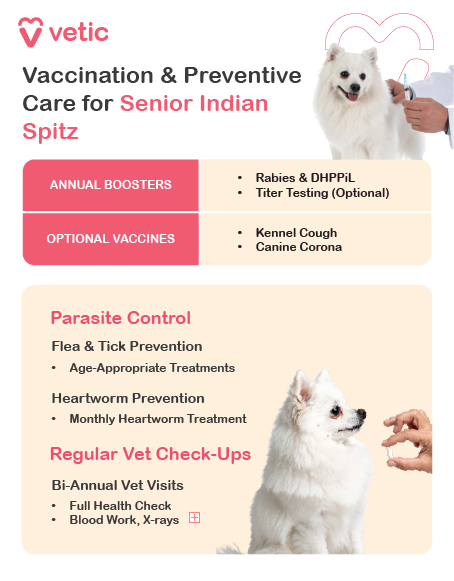
Vaccinations
Even in their senior years, Indian Spitz dogs benefit from continued vaccination—but it may need to be personalised based on health status and lifestyle.
- Core Boosters: Vaccines like Rabies, Distemper, and Parvovirus may still be recommended annually or every three years. Your vet will advise based on your dog’s age, immunity, and exposure risk.
- Optional Vaccines: If your Spitz still visits parks, grooming centres, or travels frequently, your vet may continue recommending Bordetella (kennel cough) or Canine Corona vaccines.
Parasite Control
Yes, your older dog still needs protection from creepy crawlies.
- Flea & Tick Prevention: Year-round protection is crucial, especially if your dog spends time outside. Choose gentler formulas for aging, sensitive skin.
- Heartworm Prevention: Monthly prevention is still important, especially in mosquito-prone areas. Your vet may suggest annual heartworm testing.
Senior Wellness Check-Ups
From age 8 and up, senior Indian Spitz dogs should ideally see the vet twice a year for complete wellness exams. These appointments help catch age-related changes early.
Your vet may recommend:
- Blood work to assess organ function
- Urinalysis to detect kidney or urinary issues
- Thyroid tests to screen for hypothyroidism
- X-rays or ultrasounds if signs of joint pain, heart changes, or internal concerns appear
Common Senior Health Concerns in Indian Spitz Dogs
Joint & Mobility Issues
Smaller dogs aren’t immune to arthritis. Watch for signs like:
- Stiffness when getting up
- Slower movement
- Reluctance to jump onto furniture or climb stairs
Weight Fluctuations
Senior Spitz dogs may gain weight as they slow down—or lose weight due to dental or metabolic issues. Regular weight monitoring is key.
Hypothyroidism
Indian Spitz dogs can be prone to low thyroid function, which can cause:
- Lethargy
- Skin issues
- Sudden weight gain
Heart Health
Older dogs may develop mild heart conditions. Look for signs like:
- Coughing
- Laboured breathing
- Reduced stamina on walks
Dental Problems
Tartar, gum disease, or tooth loss can affect eating and overall health. Watch for:
- Bad breath
- Drooling
- Pawing at the mouth
- Eating more slowly or reluctantly
Cognitive Decline
Canine Cognitive Dysfunction (doggie dementia) can appear with age. Watch for:
- Disorientation
- Restlessness at night
- Change in sleep or social habits
- Increased anxiety or vocalisation
When to See the Vet Immediately
Don’t delay if you notice:
- Difficulty standing, walking, or climbing stairs
- Sudden weight gain or unexplained loss
- Excessive coughing or panting with minimal activity
- Noticeable change in appetite, water intake, or bathroom habits
- New lumps, bumps, or swelling
- Signs of confusion, wandering, or pacing at odd hours
Even subtle shifts in behaviour can signal something deeper. Early detection and proactive treatment can significantly improve your senior Spitz’s quality of life.
Final Thoughts
Your senior Indian Spitz may be quieter now, but they’re still full of love and loyalty. With a thoughtful care routine, regular vet support, and plenty of affection, your furry companion can continue enjoying their golden years in good health and high spirits.
Indian Spitz Senior: Activity and Behaviour Training Guide
Senior Indian Spitz dogs (typically 8 years and older) may not bounce around like they used to, but they still need regular physical and mental activity to stay healthy and emotionally balanced. As their energy softens and their senses may change, gentle exercise, mental stimulation, and patience-based training become essential tools for their well-being.
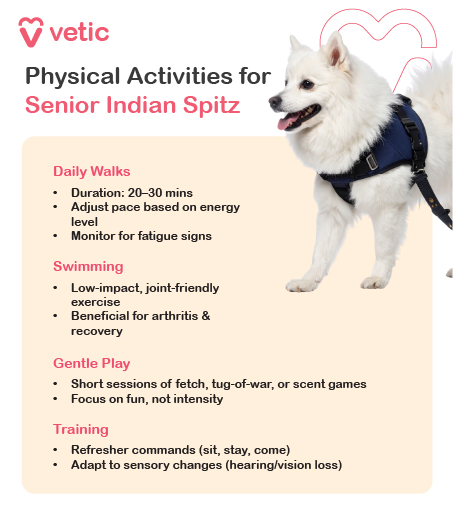
Gentle Physical Activities for Older Spitz Dogs
Even though your senior Spitz may slow down, exercise remains important to manage weight, mobility, and mood.
Daily Walks
Continue with twice-daily walks, around 15–25 minutes each, adjusting pace based on your dog’s energy and joint condition. Allow sniff breaks—these are mentally enriching and relaxing.
Low-Impact Play
Gentle games like light fetch with a soft toy or indoor hide-and-seek can keep your dog engaged without overexerting them.
Joint-Friendly Movement
If you have safe access to a shallow water space, some senior Spitzes may enjoy supervised water play, though this breed isn’t typically a swimmer like retrievers. Avoid stairs and jumping activities to protect aging joints.
Senior-Friendly Training Approach
Training isn’t just for the young. For your senior Spitz, it helps reinforce familiarity, build confidence, and keep their mind active.
Refresher Commands
Revisit simple commands like “sit,” “stay,” and “wait.” Keep sessions short, positive, and low-pressure.
Adjusted Training for Aging Senses
If your dog’s hearing or eyesight is fading, incorporate hand gestures, light touch cues, or vibration-based signals (like a gentle foot tap) to communicate more effectively.
Mental Stimulation: Keep That Sharp Spitz Mind Working
Mental activity helps delay cognitive decline and curb anxiety or restlessness. Try these:
- Puzzle toys designed for older dogs
- Scent games using hidden treats or favourite toys
- Interactive sessions that combine gentle movement and reward-based learning
- Name-recognition games or new (low-effort) tricks like “shake” or “touch”
Common Behavioural Issues in Senior Spitz Dogs
With age, behavioural shifts may appear due to discomfort, confusion, or sensory loss.
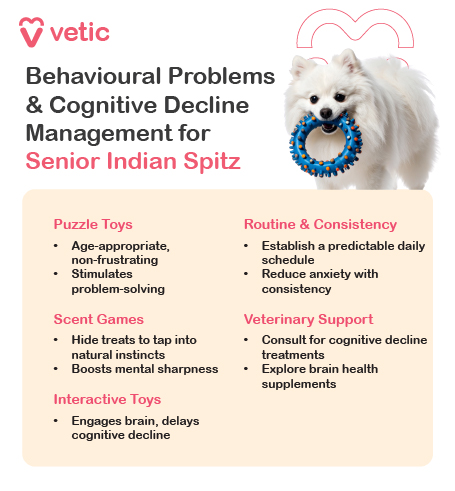
Separation Anxiety
Some senior Spitzes become more dependent and stressed when alone. Offer a quiet, secure resting space with a soft bed, familiar toys, and background noise (like soft music or a fan). You can also leave safe enrichment toys when stepping out.
House Soiling
Accidents may occur due to incontinence or cognitive dysfunction. Increase potty breaks, avoid scolding, and consult your vet for underlying medical causes.
Increased Vocalisation
Your once watchful barker may now bark out of disorientation, discomfort, or anxiety. Stay calm, gently redirect them, and rule out medical causes or environmental stressors.
Behavioural Support and Solutions
Gentle, Positive Reinforcement
Use treats, praise, or soft affection to encourage desired behaviours. Avoid punishment—it can increase anxiety and lead to confusion, especially if cognitive decline is involved.
Structure and Routine
Stick to predictable schedules for meals, walks, sleep, and medications. Routines help senior dogs feel safe and in control of their environment.
Safe and Comfortable Spaces
Ensure your dog has a warm, draft-free resting area with supportive bedding. If they’re restless or anxious, try calming aids like vet-approved pheromone diffusers or weighted blankets (if tolerated).
Supporting Cognitive Health in Senior Spitz Dogs
If you notice signs like confusion, wandering at night, or disrupted sleep patterns, your dog could be experiencing Canine Cognitive Dysfunction (CCD).
What helps:
- Brain games and puzzles
- Short daily training refreshers
- Calm, enriching environments
- Vet-prescribed supplements or medications to support brain function
Final Thoughts
Your senior Indian Spitz may not run laps around the house anymore, but their need for connection, activity, and routine never fades. With gentle movement, mindful training, and extra affection, you’ll help your aging Spitz remain mentally sharp, emotionally secure, and physically comfortable in their golden years.
Who Should Adopt an Indian Spitz?
For first-time pet parents, the Indian Spitz offers the perfect blend of loyalty, intelligence, and low-maintenance charm. They’re quick learners, thrive in apartments, and form strong bonds with their families. However, they do best with pet parents who can handle a little sass, enjoy interactive play, and appreciate a dog who might just outsmart them. Ideal for small families, working professionals, or older adults seeking a lively yet manageable companion—this native breed brings companionship with character.
